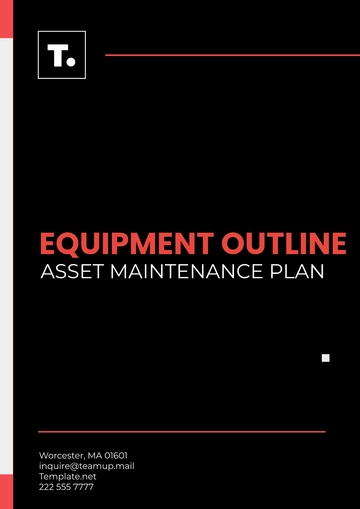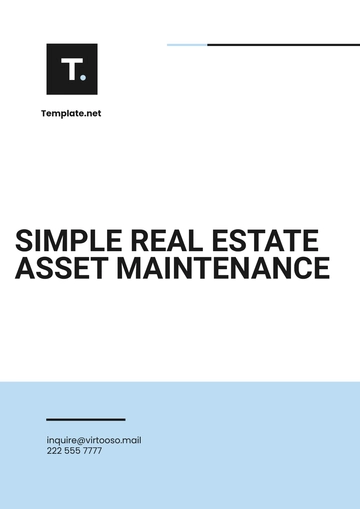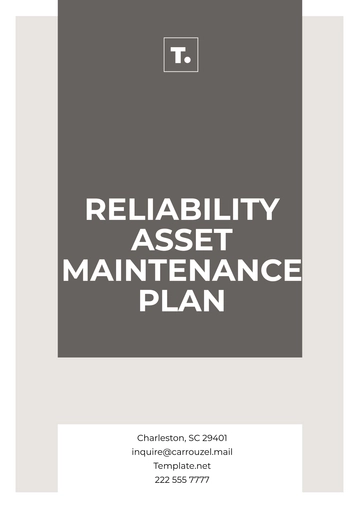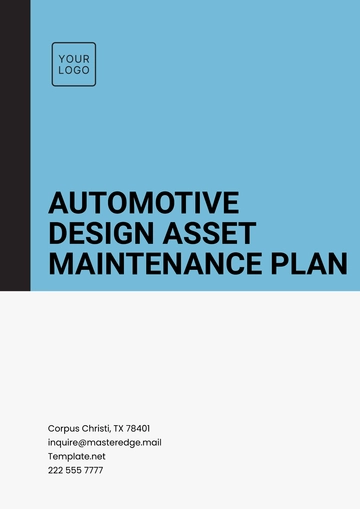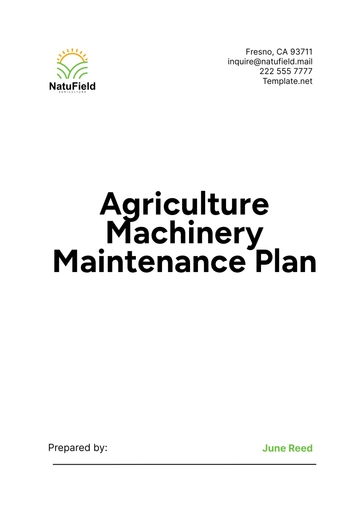Free Industrial Asset Maintenance Plan

Prepared by: [Your Name]
Company: [Your Company Name]
Date: [Date]
I. Asset Inventory
The asset inventory serves as the foundation of the maintenance plan. It is a comprehensive register of all physical assets within an industrial facility that require upkeep. Regularly updating this inventory ensures all assets are properly managed and maintained for optimal performance.
A. Asset List
Asset ID: Each asset is assigned a unique identification number, facilitating easy tracking and maintenance.
Asset Type: Machinery (e.g., pumps, motors), infrastructure (e.g., HVAC systems), vehicles, and other vital equipment used in production or facility management.
Manufacturer and Model: Information about the manufacturer and the specific model to assist with sourcing parts and understanding operational limits.
Location: The precise location of each asset within the facility or plant, including room or section.
Criticality: Each asset is categorized based on its criticality to operations (e.g., high, medium, low). Critical assets, such as safety equipment or central production machinery, require more frequent monitoring.
B. Asset Condition
Current Condition: A status report on each asset, including age, wear, and maintenance history. This section includes an evaluation of whether the asset is performing as expected or showing signs of potential failure.
Maintenance History: A detailed record of all repairs, inspections, upgrades, and part replacements, allowing teams to track any recurring issues and the lifecycle of individual parts.
II. Maintenance Strategy
The maintenance strategy outlines the planned approach for maintaining each asset type to minimize downtime and reduce unexpected breakdowns. This strategy includes preventive, predictive, and corrective maintenance methods tailored to each asset's needs.
A. Preventive Maintenance
Objective: To carry out scheduled activities that will prevent unforeseen breakdowns and prolong asset lifespan.
Tasks: This includes regular lubrication of moving parts, cleaning air filters, changing fluids, calibrating instruments, and performing visual inspections to identify wear and tear.
Frequency: Preventive maintenance tasks are assigned based on manufacturer recommendations or experience, such as weekly inspections of HVAC systems, monthly checks for pumps, and quarterly calibration of critical instruments.
B. Predictive Maintenance
Objective: Predicting potential failures before they occur, using asset data and performance metrics.
Tools: This section may incorporate techniques such as vibration analysis for motors, pressure monitoring for piping systems, and thermographic inspections for electrical systems to detect potential failures early.
Intervention Trigger: Predictive maintenance activities are initiated when metrics, such as temperature, vibration levels, or fluid pressure, reach a threshold indicating that an asset is likely to fail soon.
C. Corrective Maintenance
Objective: To address unplanned breakdowns or asset failures as they occur, ensuring swift and efficient repairs.
Action Plan: A well-defined protocol for dealing with emergencies, such as ensuring that the necessary spare parts are available, technicians are on call, and operations are safely resumed after failure.
Response Time: A clear response timeline is set based on asset criticality. For example, a critical machine failure may have a response time of 2 hours, while non-essential equipment may allow a longer response time.
III. Maintenance Schedule
The maintenance schedule ensures that all necessary tasks are completed within their specified timeframes. It helps allocate resources effectively and ensures that no tasks are overlooked.
A. Task Frequency
Routine Tasks: These are the tasks that need to be carried out on a daily, weekly, or monthly basis to ensure smooth operations. This includes monitoring pressure levels, checking temperature gauges, or greasing moving parts.
Emergency Tasks: Immediate repairs or interventions are needed when equipment fails unexpectedly. For example, repairing a broken conveyor belt in the production line or replacing a faulty valve in the water treatment system.
B. Timeline
Short-Term Schedule: Tasks that need to be executed within the next few days or weeks. For example, weekly inspections of water treatment equipment and monthly calibration of temperature control systems.
Long-Term Schedule: Includes tasks that are scheduled quarterly, semi-annually, or annually. These may include overhauls, full inspections, and major repairs or replacements.
IV. Resources and Budget
This section outlines the human, material, and financial resources necessary to execute the asset maintenance plan effectively. Proper allocation of these resources ensures the maintenance process runs smoothly without resource shortages or budget overruns.
A. Personnel
Maintenance Team: A skilled team comprising technicians, maintenance engineers, and facility managers. Each team member is assigned roles based on expertise—such as HVAC maintenance, electrical system upkeep, or mechanical repairs.
Training Requirements: Maintenance personnel will receive ongoing training to stay updated on best practices, safety standards, and compliance regulations. Training programs will include both theoretical and hands-on components.
B. Tools and Equipment
Tools List: A comprehensive list of tools required for each task, such as calibration equipment, safety gear, lubricants, and diagnostic devices.
Spare Parts Inventory: Maintaining a stock of frequently used parts like filters, seals, gaskets, and electrical components ensures that repairs can be made promptly without waiting for deliveries.
B. Budget
Cost Estimates: Each maintenance task is assigned an estimated cost, including labor, parts, and tools. This estimate helps to determine whether the maintenance plan is within the available budget.
Budget Allocation: The overall maintenance budget is broken down by department and asset category. For example, higher amounts may be allocated to critical production machines and HVAC systems, while smaller budgets may be assigned to non-essential equipment.
V. Risk Management
Identifying and mitigating risks ensures that assets operate efficiently and that unexpected breakdowns or accidents are minimized. Effective risk management is essential for both safety and operational continuity.
A. Risk Identification
Asset Failures: Evaluating the potential risks of failure for each asset. For instance, a critical air compressor failure could halt production, while a non-critical light bulb burnout would have minimal impact.
Operational Risks: The risks to operations, such as production delays, supply chain disruptions, or safety hazards due to equipment failure, must be identified and mitigated through preventive measures.
Environmental Risks: Consideration of external risks, such as extreme weather events, that may affect facility operation. For example, flooding could impact water systems, while storms might damage roof-mounted equipment.
B. Mitigation Strategies
Preventive Measures: Installing backup systems, such as redundant power supplies or backup generators, can mitigate the risks of sudden power outages.
Emergency Procedures: Detailed action plans outlining what to do in case of asset failure. These include communication strategies, safety measures, and protocols for identifying and fixing the problem quickly.
VI. Performance Monitoring
Continuous monitoring ensures that assets are performing as expected and that maintenance interventions are effective. Regular assessments help optimize the asset lifecycle and reduce maintenance costs.
A. Key Performance Indicators (KPIs)
Downtime: Monitoring unplanned downtime across all assets. A KPI threshold for each asset can be set to track performance, aiming for minimal downtime.
Maintenance Costs: Tracking costs associated with preventive, corrective, and emergency maintenance. These metrics help ensure the maintenance budget is managed efficiently.
Asset Efficiency: Measuring output against the potential of each asset. This includes assessing energy consumption, operational speed, and the effectiveness of machinery about its operating cost.
B. Reporting
Maintenance Reports: A regular (monthly or quarterly) report that summarizes all completed, ongoing, and pending maintenance activities. These reports are distributed to management and other relevant departments.
Performance Reviews: Periodic evaluations of asset performance, including any discrepancies between expected and actual performance. These reviews inform adjustments to the maintenance strategy.
VII. Compliance and Documentation
Compliance ensures that all maintenance activities are carried out by local laws, industry standards, and safety regulations. Proper documentation is crucial for legal purposes and quality assurance.
A. Regulatory Compliance
Industry Standards: Compliance with industry regulations such as OSHA for safety, ISO 55001 for asset management, or environmental standards set by local authorities.
Environmental Regulations: Ensuring that maintenance tasks do not harm the environment, such as managing waste from asset repairs or ensuring proper disposal of hazardous materials like oil.
B. Documentation
Maintenance Logs: A record for every maintenance activity that includes date, work performed, parts replaced, and technician details. This log is essential for audits and performance reviews.
Inspection Records: Documentation of all routine inspections, including findings, actions taken, and follow-up tasks. These records help track the history of asset conditions and can be referenced for future maintenance.
- 100% Customizable, free editor
- Access 1 Million+ Templates, photo’s & graphics
- Download or share as a template
- Click and replace photos, graphics, text, backgrounds
- Resize, crop, AI write & more
- Access advanced editor
Boost industrial asset performance with our Industrial Asset Maintenance Plan Template from Template.net. This editable and customizable template is tailored to the demanding needs of industrial environments. Editable in our Ai Editor Tool, it helps streamline maintenance schedules, reduce downtime, and improve asset reliability, ensuring consistent operations and efficiency. Get started today for a more organized maintenance process.
You may also like
- Finance Plan
- Construction Plan
- Sales Plan
- Development Plan
- Career Plan
- Budget Plan
- HR Plan
- Education Plan
- Transition Plan
- Work Plan
- Training Plan
- Communication Plan
- Operation Plan
- Health And Safety Plan
- Strategy Plan
- Professional Development Plan
- Advertising Plan
- Risk Management Plan
- Restaurant Plan
- School Plan
- Nursing Home Patient Care Plan
- Nursing Care Plan
- Plan Event
- Startup Plan
- Social Media Plan
- Staffing Plan
- Annual Plan
- Content Plan
- Payment Plan
- Implementation Plan
- Hotel Plan
- Workout Plan
- Accounting Plan
- Campaign Plan
- Essay Plan
- 30 60 90 Day Plan
- Research Plan
- Recruitment Plan
- 90 Day Plan
- Quarterly Plan
- Emergency Plan
- 5 Year Plan
- Gym Plan
- Personal Plan
- IT and Software Plan
- Treatment Plan
- Real Estate Plan
- Law Firm Plan
- Healthcare Plan
- Improvement Plan
- Media Plan
- 5 Year Business Plan
- Learning Plan
- Marketing Campaign Plan
- Travel Agency Plan
- Cleaning Services Plan
- Interior Design Plan
- Performance Plan
- PR Plan
- Birth Plan
- Life Plan
- SEO Plan
- Disaster Recovery Plan
- Continuity Plan
- Launch Plan
- Legal Plan
- Behavior Plan
- Performance Improvement Plan
- Salon Plan
- Security Plan
- Security Management Plan
- Employee Development Plan
- Quality Plan
- Service Improvement Plan
- Growth Plan
- Incident Response Plan
- Basketball Plan
- Emergency Action Plan
- Product Launch Plan
- Spa Plan
- Employee Training Plan
- Data Analysis Plan
- Employee Action Plan
- Territory Plan
- Audit Plan
- Classroom Plan
- Activity Plan
- Parenting Plan
- Care Plan
- Project Execution Plan
- Exercise Plan
- Internship Plan
- Software Development Plan
- Continuous Improvement Plan
- Leave Plan
- 90 Day Sales Plan
- Advertising Agency Plan
- Employee Transition Plan
- Smart Action Plan
- Workplace Safety Plan
- Behavior Change Plan
- Contingency Plan
- Continuity of Operations Plan
- Health Plan
- Quality Control Plan
- Self Plan
- Sports Development Plan
- Change Management Plan
- Ecommerce Plan
- Personal Financial Plan
- Process Improvement Plan
- 30-60-90 Day Sales Plan
- Crisis Management Plan
- Engagement Plan
- Execution Plan
- Pandemic Plan
- Quality Assurance Plan
- Service Continuity Plan
- Agile Project Plan
- Fundraising Plan
- Job Transition Plan
- Asset Maintenance Plan
- Maintenance Plan
- Software Test Plan
- Staff Training and Development Plan
- 3 Year Plan
- Brand Activation Plan
- Release Plan
- Resource Plan
- Risk Mitigation Plan
- Teacher Plan
- 30 60 90 Day Plan for New Manager
- Food Safety Plan
- Food Truck Plan
- Hiring Plan
- Quality Management Plan
- Wellness Plan
- Behavior Intervention Plan
- Bonus Plan
- Investment Plan
- Maternity Leave Plan
- Pandemic Response Plan
- Succession Planning
- Coaching Plan
- Configuration Management Plan
- Remote Work Plan
- Self Care Plan
- Teaching Plan
- 100-Day Plan
- HACCP Plan
- Student Plan
- Sustainability Plan
- 30 60 90 Day Plan for Interview
- Access Plan
- Site Specific Safety Plan





